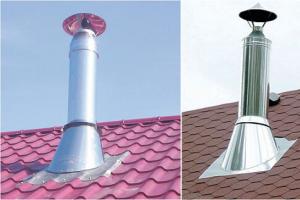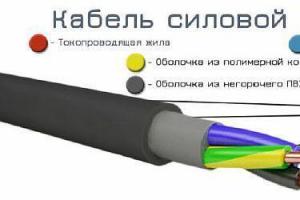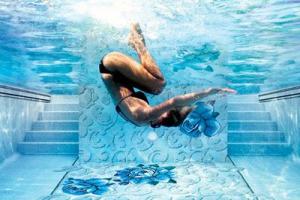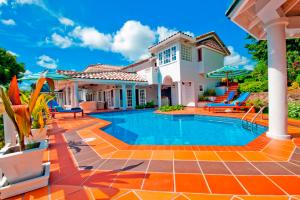When creating a pool, you need to take into account many complex technical issues: arrangement of the foundation, waterproofing of the bowl, filtration systems, drainage and water supply. But few people pay due attention to cladding. In this article we will talk about what a good pool tile should be and what you should pay attention to when choosing it.
Quick navigation through the article
Cladding requirements
- Pool tiles should have a low water absorption coefficient. According to European standards UNI EN 99, water absorption should not exceed 6%. This is a very important indicator, since over time, tiles soaked in water become brittle.
- Another important requirement for pool tiles is chemical resistance. The cladding must withstand exposure to bleach and detergents.
- The tiles must be impact-resistant, frost-resistant and resistant to sunlight.
According to the EU Construction Materials Directive 93/68/EWG, manufacturers divide tiles into slip classes. It is usually written on the packaging.
- Class A – suitable only for dry rooms (eg locker rooms).
- Class B - can be used in showers, edges for approaches to the pool and areas around it.
- Class C – has the best anti-slip performance. These tiles are suitable for laying on steps and inclined slopes that go under water.
Ordinary tiles are not designed for constant contact with water. It will quickly collapse, and moisture will first begin to affect the waterproofing, and then reach the foundation. In addition, a plaque of bacteria and microorganisms will accumulate on ordinary tiles, which, no matter how you clean it, will still form a slimy film and mold on the surface.
Material selection
What materials meet the requirements described above?






First of all, it is glass. Covering the pool with glass mosaic is the most popular option, since the water absorption of such material is close to zero. 
Glass perfectly withstands temperature changes from -30 to +145 degrees, and can survive up to 100 freeze-thaw cycles, and this is important for outdoor pools.
Glass mosaic successfully withstands contact with most types of acids; over time it will not lose its appearance, the paint will not fade or peel off.
Even if some part gets damaged, it can be easily replaced with a new one, and no one will even notice the patch.
Pool mosaics are most often square in shape. The smaller its size, the easier it will be to cover irregularities and bends.
To speed up the installation process, manufacturers pre-glue the parts onto a mesh, the size of which is usually 30*30 or 60*60 cm. They are glued with a special tile adhesive, and then a waterproof grout is applied.
There are many mosaic manufacturers now: Italian Trend, Vitrex, Aquileia and Bisazza, Spanish Vidrepur and others. The price range is quite large: from 600 to 35 thousand rubles per square meter, depending on the shape and decorative qualities.
Porcelain tiles
Like porcelain tableware, tiles are made from a mixture of several types of white clay, kaolin, feldspar and quartz. Coloring occurs by adding pigments to the composition, most often metal oxides. 
The tile is fired at a temperature of 1200-1300 degrees. The result is a very durable product with a glassy surface that does not require additional glazing.
Clinker tiles

Highly plastic clays with many additives are used to make clinker. The plates are made using extrusion or pressing, and then fired at a temperature of about 1200 degrees. Due to this, water absorption is only 0.5%.
Clinker has high strength, so large format tiles can be used for the pool - 294*294*10 mm. It does not crack from exposure to water and can withstand good mechanical loads. Glazed and unglazed clinker tiles are similar in their characteristics. The main difference is that the glazed surface will be smooth, which is well suited for lining a pool bowl. The floor can also be covered with ordinary clinker without glaze; it is not afraid of water.
Clinker tiles practically do not slip, unlike ordinary tiles or natural stone tiles, so there is no need to worry about safety.
On average, the price of clinker tiles is 900-4000 rubles per square.
To cut clinker you will need an electric tile cutter with a diamond blade; even a professional manual tile cutter will find it difficult to cut it.
Water overflow systems

In order not to once again subject the lining around the pool to a “strength test”, you need to protect it from water overflows. Of course, the easiest way is to lower the water level in the pool, but imagine how difficult it will be to get out of it. To maintain a high water level, but solve problems with overflow, edge elements for the sides and overflow gutters should be installed around the perimeter of the pool, which will be covered with a grill.
Size and shape
To prevent the tiles at the bottom of the pool from cracking, they should not be too large. It is not recommended to use tiles larger than 125*250 or 150*150 mm, and for bowls of complex shape - a maximum of 100*100 mm.
To facilitate cladding, there are special shaped products for finishing sides, steps, and creating gutters. Corners covered with such products will collect less dirt. 
Tile adhesive and grout
When tiling, use special tile adhesive for swimming pools (for example, UNIS Pool, IVSIL AQUA, Pobedit Pool). The average consumption of the dry mixture is 1.4-1.5 kg per square meter with a layer thickness of 1 mm. In practice, the consumption will greatly depend on the evenness of the base, the size of the teeth on the spatula and its angle of inclination - from 2.3 kg to 7 kg of mixture.
A two-component epoxy grout is used for the pool.
Conclusion
Compared to the budget option made of PVC, tiles and mosaics for a swimming pool have a large number of advantages: beautiful appearance, resistance to damage, durability, are not afraid of frost and can be repaired. This is the best option if you are going to make a pool for yourself and for a long time.
comments powered by HyperCommentsNo similar entries found.
Swimming pools - both in sports complexes and in private properties - need high-quality finishing. And there is no better option for decorating the bowl, steps, floor around and walls than special pool tiles.
The specifics of indoor and outdoor swimming pools impose a number of finishing requirements. The facing tiles must be durable, comfortable to use, and also attractive in appearance.
In addition, pool tiles must have a minimum degree of moisture absorption. After all, this finishing material is constantly in contact with water, and not only the quality of the design, but also the reliability of the structure as a whole depends on how much it resists moisture.
An important quality of the tiles used to decorate the pool bowl and its surroundings is durability. There is a lot of water in any pool, its weight is considerable, and multi-ton operating pressure is constantly applied to the surface of the tiles.
Tile density is also important. There should be no voids or cracks in the “body” of the material. Only a homogeneous structure is the key to the integrity and safety of finishing tiles for a long time.
And the quality of facing tiles seriously affects the hygiene and physical safety of a structure such as a swimming pool. Wherever he is:

Types of finishing tiles
Modern pool tiles differ not only in color and size. It is also classified according to other characteristics. For example, intended for:
- — open pool bowls;
- — indoor swimming pools;
- — surface and underwater stages;
- - the bottom of the pool.
Important: The characteristic of minimal moisture absorption is important not only for the finishing tiles used, but also for the grout used to process the joints.
Clinker

The ideal option for such a specific finish is clinker tiles. It is practical, non-slip, looks great visually, and is easy to clean. Does not absorb moisture (water absorption rate less than 3%) and is absolutely hygienic. In addition, it is resistant to any aggressive influence: atmospheric, mechanical, chemical. Clinker tiles have a very special manufacturing process: flux, fireclay and oxide dyes are added to the base clay. This is followed by pressing and kiln firing at ultra-high temperatures. And that is why the finished material can withstand multi-ton and super-complex operating loads.
Tile
Another great option for pool design is tiles. According to European standards, it is considered anti-slip and is divided - according to the same criterion - into 3 classes:

Ceramics: tiles + mosaic
Ceramic tiles are one of the most optimal design variations for pool interior elements. It has almost the same characteristics as clinker, but is much more diverse in terms of design.
Anti-slip ceramics are used on the floors and walls of indoor public and private swimming pools. And for these purposes they use ceramic mosaics, which have brilliant aesthetic and performance qualities.
Mosaic finish:

- - has a lot of tint solutions and design options;
- - strong, reliable, durable;
- — suitable for creating panels in bowls, on the walls and floors of swimming pools.
This mosaic can be glazed or unglazed. But in both cases, it stimulates the creative imagination of designers to create truly highly artistic interiors for swimming pools, showers, and bathrooms.

How to choose tiles or mosaics for your pool
Not only the appearance, but also the safety of the artificially created aquazone depends on how correctly the tiles for the pool are chosen.
It doesn’t matter what material is chosen for finishing an indoor or outdoor pool for aesthetic reasons, it is important that it has high quality characteristics.
Tiles or mosaics for the floor, steps and bottom of the bowl must be anti-slip, durable and resistant to moisture. After all, this material will be used in extremely difficult conditions.
Cladding technology
Of course, there are few people who want to equip and tile a private pool on their own. Not to mention public bowls. This is not a cheap pleasure, and qualified specialists with extensive similar experience are invited to build and finish it.
And yet, when controlling the finishing work, it would be nice to know a number of rules for tiling with mosaics, clinker or ceramic tiles.
For example, finishing material is laid exclusively on a prepared, namely waterproofed surface. The finishing adhesive is selected in accordance with the requirements of the tile itself and the surface on which the tile will need to be laid using a special notched trowel.

Important: The position of the tiles is adjusted by the amount of glue: when laying, you must press firmly on the ceramic (or any other used) surface, ensuring its strong adhesion to the base. By the way, such fastening of the material will make the latter even safer: anti-slip plus reliably motionless.
After laying mosaics or tiles, you should use the correct grout for the joints. It must also be waterproof and visually ideally match the selected facing material.
In principle, there is absolutely nothing complicated in the technology of laying clinker (or ceramic) tiles or mosaics. The main difficulty is to lay it all out smoothly, to start where you need it and finish where you need it. Maintain the design solution flawlessly correctly, without violating the geometry and artistic component. This requires professionalism and a lot of experience.
Rules for caring for the surface of the pool bowl and its surroundings
A decorated outdoor or indoor pool requires maintenance. In sports centers, this is done by special staff, but in private properties, care for the structure falls entirely on the shoulders of the property owners.

Caring for anti-slip tiles and mosaics is simple; it is important to maintain the brightness and beauty of the surfaces and protect them from aggressive biological activity.
If the mosaic panel or tiled ornament is designed in light shades, it is necessary to choose household chemicals that promise an effective fight against yellowness. If we are talking about darker tones, they need their own means to guarantee the absence of a whitish coating and unsightly stains.
On a note: Plus, you need to constantly maintain the anti-slip properties of the finishing material used. This means no polishes, slippery rubs or other surface-glazing compounds. They can make the elements of your home pool much more dangerous.
In principle, if the anti-slip tiles were correctly selected for various surfaces (taking into account all the requirements), maintenance difficulties should not arise. But to maintain and clean such a serious structure as a swimming pool, it is more correct to contact specialized companies that guarantee, literally and figuratively, a brilliant result.
For a stationary pool, high-quality facing ceramic tiles are very important, which can not only guarantee waterproofing of the walls, but also provide a beautiful appearance. Finishing a pool requires special tiles, or better yet porcelain tiles, of special strength that can withstand the highest pressure of the water column. And it must have a minimum level of hygroscopicity. Only in this case, the ceramic tiles for the pool, unlike the usual ceramic version used for other purposes, will not absorb water and further crumble.
For greater safety, manufacturers deliberately make porcelain tiles for pools in relief - slipping on them is not considered possible. If the tiles are installed on the floor and walls of the pool correctly, i.e. on the reinforcing wall and on special solutions that are not afraid of water, then it can truly last for several decades. Even if the water in the pool remains in the winter!
Pool tiles - best sellers
Drainage channels made of high-quality ceramics are also considered a necessary and integral part of a stationary pool. They are installed behind the edge of the pool. They are able to collect excess water and then direct it downwards for purification into a sand filter. Drainage channels are considered necessary for those pools that are not equipped with water intakes in the form of skimmers. next to the drainage channels should also have a structured anti-slip surface, which is valuable from a safety point of view - a person walking near the side will never slip and injure himself.
Pool tiling
The construction of any pool is completed by its finishing. Among the variety of ways to give a pool an aesthetic appearance, tiling is popular. Due to the specific nature of the application, this process has a lot of nuances and subtleties, which is why such complex work is most often entrusted to specialists. However, if necessary and knowledge of the rules, this work can be done independently.
Preparatory work
Styling adhesive
It is recommended to use elastic adhesive for tiling swimming pools with ceramic tiles. This binder material “levels out” the stresses that appear between the tile and the base during temperature changes, which preserves the integrity of the coating. To cover glass mosaic tiles, it is more advisable to use glue with the addition of latex.
Stages of ceramic finishing
Laying tiles begins no earlier than 2 days after installing the waterproofing. First, a project is drawn up, on the basis of which the required amount of material is determined, taking into account the possible pattern on the surface and those pieces that will have to be cut. The cladding starts from the walls and is carried out, as a rule, from the middle of the bottom row so that the broken tiles are located exclusively in the corners.
The set of tools is standard for any “tile” work: tile cutter, spatulas, trowel, rubber hammer, level and guides (beacons and fishing line).
First, the horizontal level of the masonry is determined, for which a fishing line is pulled between the measured points along the edges of the pool. The glue is applied to the wall to the width of three tiles. The first (and subsequent rows) are laid with the same spacing between tiles (measured by distance crosses). The joints are filled halfway with glue. The uniformity of the layer height is ensured by light blows with a rubber hammer on the attached wooden strip. After the geometry of the first row is ensured, proceed to laying the second in the same way. The edges of the pool are lined in compliance with the corners of the overflow edge. If necessary, the steps are lined.
Once the walls are laid, work on the floor begins. It is carried out in a similar way, taking into account several features: the arrangement of drainage zones, each of which is lined separately.
To ensure long service life and ease of cleaning, the transition between the walls and the floor is lined with special rounded elements.
Elastic seams
In addition to the main seams, when lining the pool, so-called elastic seams filled with sealant must be made - approximately 3 m in each direction (a square of 3x3 m is obtained). These seams coincide with the tile seams and serve to “compensate” for expansion. They must be performed in all corners and joints. Grouting joints. The seams between the tiles require additional grouting. It is done after the glue has dried - no earlier than 24 hours after laying the tiles. First, glue residues, crosses, etc. are removed from the seams. Cement and epoxy materials are used to grout pool tiles.
The seams are filled with a rubber spatula using diagonal movements to the full depth. Excess is removed with a soft sponge when the grout loses its elasticity (after 5-20 minutes). If you rush, the seams will “wash out”.
The pool is filled with water a month after finishing.
Materials and technologies | №4 (71) "2013
After the construction of the pool bowl and the arrangement of the pool area, the question invariably arises of choosing a facing material for finishing. Facing materials made of ceramics and glass will never go out of fashion due to their water resistance, resistance to chemicals, rich decorativeness, variety of colors, textures and formats.
A swimming pool is a complex hydraulic structure, so special requirements are placed on its facing materials. They must have a number of technical characteristics that meet the specific conditions of their operation: first of all, zero or close to zero coefficient of water absorption, impact resistance, frost resistance, as well as resistance to ultraviolet radiation and the action of chemical reagents. That is why ordinary tiles used for tiling, for example, a kitchen or bath, are absolutely not suitable for a swimming pool.
Basic technical requirements
One of the most important criteria when choosing tiles for laying in a pool is its minimum water absorption (this indicator directly depends on the porosity of the tile - the larger it is, the higher the water absorption). It is this parameter that guarantees the durability of the facing material, and therefore the service life of the entire structure. After all, even the slightest seepage of water into the porous base of the tile can make it brittle and brittle and lead to the gradual destruction of not only the finishing coating, but also to the violation of waterproofing and protection of the structural elements of the pool. Therefore, if the lining of the pool bowl was carried out without taking this requirement into account and the finishing ceramics turned out to be insufficiently waterproof, the material will have to be completely changed - there is no other way out. According to the unified European standard UNI EN 99, the water absorption coefficient of tiles designed specifically for a swimming pool should not exceed 3%.
Water absorption also significantly affects the ultimate strength of the tile, or its ability to resist bending loads. And only a material with a dense structure and low porosity will give excellent results, withstanding multi-ton water pressure on the walls and floor of the pool bowl.
In addition, the absence of pores and voids in the body of the tile eliminates the possibility of the appearance and reproduction of various bacteria and microorganisms in them, which actively destroy the lining from the inside and secrete a mucous coating, which makes it slippery and dangerous and is an additional factor in water pollution.
The finishing of the aquazone must be resistant to aggressive environments. The water in the pool either contains chlorine or has a low pH level, and the lining must be periodically washed with special cleaning agents. Therefore, in order to minimize and simplify the maintenance of the pool, for lining the bowl it is necessary to choose a material with a perfectly flat, smooth surface. Such characteristics will save both money and time.
Anti-slip surface
Special attention should be paid to the tiles intended for laying the floor of the aqua zone. The fact is that water can accumulate on the floor in such places, so there is a risk of slipping and injury. This is why floor tiles for swimming pools and the rooms in which they are located are subject to the European Union Building Materials Directive 93/68/EWG, which sets standards for anti-slip flooring. To give the tile an anti-slip (anti-slip) effect, various notches or a relief pattern or a special composition are applied to its surface, making it rough.
According to the DIN 51097 standard, there are three classes of such coatings used in areas such as baths, swimming pools, showers, that is, where people walk barefoot. Each class corresponds to a specific installation area. Class A includes materials suitable for covering floors in locker rooms and other fairly dry rooms. Class B tiles are intended for showers, pool walkways, inclined edges and approaches to them. For finishing the steps of the stairs, as well as inclined slopes that go under water, class C materials are used, which have the highest anti-slip rating.
Sizes and shapes
There are certain restrictions regarding the shape and size of finishing elements. You cannot tile the pool bowl with any tile you like, and a large one at that. This is explained by the fact that its walls and bottom are subject to enormous mechanical water pressure, which even a powerful structure may not withstand. Therefore, in order for the tile to maintain its integrity in such extreme conditions and not peel off from the base, its dimensions should not be larger than those provided for by the Olympic standard - 12.5x24.5 cm. Rectangular pools can be tiled with large tiles (12.5x25, 15x15 cm) , but not exceeding the specified standard, and for pools of complex configurations, smaller ceramic products are used (2x2, 2.5x5, 5x5, 10x10 cm).

The seams between the tiles are the most important compensation component in the pool, so they are made a little wider than usual. Determine the thickness of the seam based on the size of the tile (mosaic).
Ceramic tile sets may include special shaped products and accessories designed for finishing corners, edges and sides of the pool, overflow gutters, etc. The presence of such ready-made parts greatly simplifies the cladding process, allowing you to equip the pool with the necessary safety elements without wasting time and effort, while at the same time giving it a complete stylish look.
Glass
Taking into account the coefficient of water absorption, the ideal material for lining the pool bowl is glass mosaic - an alloy of silicon sand with other components and additives of coloring oxides. Glass has zero water absorption and high water resistance. The glass mosaic coating is durable, heat- and frost-resistant, practically does not collapse and does not fade under the influence of chemicals. Moreover, it has a solid structure, which means it is not susceptible to the influence of microorganisms and bacteria and can be used for finishing swimming pools. To increase mechanical strength, the mosaic is tempered in a special way: for example, it is subjected to additional firing at that stage of the technological process when molten glass is poured into molds.
As for the color palette, it is difficult to describe, it is so rich. To achieve multi-colored glass, a wide variety of substances are added: from boron, cadmium and selenium to the semi-precious mineral aventurine and mother-of-pearl. The colors of the mosaic finish retain their brightness even under water, and thanks to its movement, the effect of the painting comes to life.
The most common form of typesetting elements (they are also called modules, chips, tesserae) is square. The smaller they are, the more detailed the image will be and the more accurate the drawing (panels, ornaments). Mosaic pieces in accordance with the selected sample are collected into matrices. The final mosaic panel, the area of which can be several square meters, is made up of these fragments already on site and installed in the same way as an ordinary tiled covering. The flexible base of the mosaic allows it to be used on any surface, including curved ones.
Ceramics
Among ceramic facing materials, only porcelain tiles and some types of clinker have the required water absorption rate. They are manufactured using technologies specifically designed to maximize density and reduce porosity of the material.
Porcelain ceramic tiles are made by pressing a mixture of white clay, kaolin, feldspars and quartz - the clay dough recipe is similar to the composition of porcelain, hence the name. To obtain different shades, coloring substances, usually oxides of various metals, are added to the mixture. After pressing (by pressing or extrusion), the products are fired at a temperature of 1250–1300°C. As a result, the components are not only sintered, but also largely melted. Thanks to this structure, porcelain ceramic tiles receive high mechanical strength and a very dense, glassy surface, so they are usually not glazed.
Clinker tiles first appeared in Holland and were originally used for paving roads - durable and strong. Today, thanks to its unique properties, the scope of application of tiles has expanded significantly. Clinker is a natural material that is made from special plastic grades of clay. Clinker tiles can also be pressed and extruded. The pressed plates are fired at high temperatures (1300–1400 °C). During the manufacturing process, glassy chamotte is added to the mass - a substance that turns the material into one of the most durable ceramic products. Due to its large thickness and density, it can withstand strong pressure, as well as significant temperature changes. To finish swimming pool bowls, glazed clinker with a water absorption of no more than 3% is used.
Matrix styling technique

The material of the matrix mosaic is identical square plates, which are manufactured industrially. During the installation process, the paper-based matrix is attached to the adhesive mixture with the wrong side. After the glue dries, the paper comes off easily if you moisten it with water. These slabs are very convenient for decorating simple straight surfaces.
Text: Elena Kulygina








